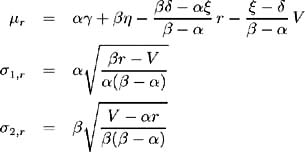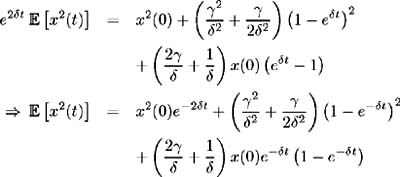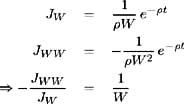Chapter 4: Longstaff and Schwartz-A Two-Factor Equilibrium Model
Longstaff and Schwartz (LS) [ 38 ] developed a two-factor model of the term structure based on the framework of Cox, Ingersoll and Ross [ 18 ] discussed in Chapter 2. The two factors are the short-term interest rate and the instantaneous variance of changes in this rate (volatility of the short-term interest rate). Therefore the prices of contingent claims reflect the current levels of the interest rate and its volatility. The choice of interest rate volatility as the second state variable is supported by the fact that volatility is a key variable in contingent claim pricing.
4.1 General framework
4.1.1 The underlying economy
The term structure is modelled within a continuous time economy where physical investment is performed by a single stochastic constant-returns-to-scale technology [1] . The single good produced by this technology is either consumed or reinvested in production. The returns realised on physical investment are described by the stochastic process:
where ¼ , and ƒ are positive constants, X and Y are state variables and z 1 is a Wiener process. X is an economic factor driving expected returns but having no effect on the uncertainty of production, while Y affects expected returns and volatility. This implies that expected returns and volatility of production are not perfectly correlated. To ensure a non-negative risk-free rate of interest, > ƒ 2 . The state variables are modelled by:
where a, b, c, d, e and f are positive and z 2 , z 3 are Wiener processes. Since X is uncorrelated to production uncertainty, we require z 2 to be uncorrelated with z 1 and z 3 .
Markets are assumed to be perfectly continuous and competitive, with a fixed number of homogeneous investors having time-additive preferences of the form:
where C s is the time s level of consumption, the utility discount function and ![]() t [] the expectation taken at time t . Here, future consumption is discounted to time t by the factor , which indicates the decreasing current utility of consumption in the future. However, if consumption is delayed, the investor is able to invest more and benefit from greater consumption in the future. Each investor wishes to maximise their utility subject to the budget constraint denoted by
t [] the expectation taken at time t . Here, future consumption is discounted to time t by the factor , which indicates the decreasing current utility of consumption in the future. However, if consumption is delayed, the investor is able to invest more and benefit from greater consumption in the future. Each investor wishes to maximise their utility subject to the budget constraint denoted by
where W is the investor's wealth and hence at any time t , the investor may either consume wealth (denoted by C ) or invest the wealth in the single technology (4.1). The derived utility function obtained as the solution to the maximisation problem, has the form [2] :
Optimal consumption and investment amounts are also determined as part of the maximisation problem. CIR (1985) [ 18 ] determined the associated optimal consumption function to take the form:
where T ’ ˆ . Hence determining the optimal consumption level to be W , the equilibrium wealth dynamics are derived to be:
Equations (4.2), (4.3) and (4.5) form a joint Markovian process, the current values of which completely describe the state of the economy.
Now rescale the state variables such that x = X/c 2 and y = Y/f 2 and define H ( x, y, ) as the value of a contingent claim with maturity . The value of this contingent claim satisfies the fundamental partial differential equation [ 17 , Theorem 3]:

where [3] ³ = a/c 2 , · = d/f 2 , = b , ¾ = e , r is the instantaneous risk-free rate of interest and covar ( dW, dY ) is the instantaneous covariance of changes in wealth W with changes in state variable Y . The coefficient of H y includes a utility-dependent term which represents the risk premium associated with the level of production uncertainty governed by Y . From (4.3), (4.4) and (4.5), we may show [4] :
Hence the risk premium (market price of risk) is proportional to y . The proportionality factor » is constant. This form of the risk premium has been endogenously derived from the specification of the underlying economy and so ensures consistency with the equilibrium characteristics of the economy. The same cannot be said of the no-arbitrage models where the form of the risk premium is exogenously defined.
Specifying the instantaneous risk-free rate of interest r , in terms of the state variables x and y , will allow us to solve (4.6) for the price of any contingent claim subject to its initial and terminal boundary conditions. Since these prices will be in terms of unobservable state variables, we make a transformation to express the contingent claim prices in terms of intuitive and readily estimated economic variables. These two economic factors are the short-term interest rate r , and variance of changes in this short-term interest rate V . Hence information about the current term structure other than its current level is incorporated. This approach has the potential to produce contingent claim valuations more consistent with actual market prices than one-factor models.
4.1.2 The observable economic variables
4.1.2.1 Definition
The equilibrium risk-free rate of interest is derived as the expected return on production less variance of production returns [ 17 , Theorem 1]. That is [5] :
where ± = ¼ c 2 and ² = ( ˆ’ ƒ 2 ) f 2 .
4.1.2.2 Stochastic processes
Applying Ito's Lemma to (4.7) we obtain the stochastic processes describing the evolution of r :
Taking expected values of the above we obtain the expression for the instantaneous variance V , of changes in the short-term interest rate as:
and since z 2 and z 3 are uncorrelated we have:
Hence

Here the notational dependence on dt is suppressed since it is implicit in the context of the definition. Now solving (4.7) and (4.9) as a system of simultaneous equations, x and y may be found as functions of r and V . Hence, assuming ± ² we have:
Now substituting these values of x and y into (4.8), the stochastic process for r , we have:
where

Similarly, from (4.9) we derive the process for V as:
where

Since the stochastic evolution of r depends on V and vice versa, the two processes are interdependent, forming a joint Markovian process.
4.1.2.3 Expected value
The methodology used to calculate the expected value of the short-term interest rate in the CIR model is applied to evaluate the unconditional expected values of r ( t ) and V ( t ). Since both r ( t ) and V ( t ) are linear combinations of x and y , we first calculate the expectations of x and y . The stochastic processes for x and y are:
First, consider the integral form of (4.14):
Taking expectations, we have:

which implies

Integrating both sides yields:
and hence we solve for ![]() [ x ( t )] as:
[ x ( t )] as:
If x (0) = ![]() , the mean reversion level, then
, the mean reversion level, then ![]() [ x ( t )] =
[ x ( t )] = ![]() for all t . Alternatively, for x (0)
for all t . Alternatively, for x (0) ![]() , the long-run mean of x ( t ) is:
, the long-run mean of x ( t ) is:
Similarly, the long-run mean of y ( t ) is calculated as:
and hence:
4.1.2.4 Variance
Since z 2 and z 3 are uncorrelated, the variance of r ( t ) (and similarly of V ( t )) may be calculated as:
where:
In order to evaluate var ( x ) and hence var ( r ( t )), we require the process dx 2 ( t ). Applying Ito's Lemma and making use of (4.14) we have:

Hence:
and
Therefore:

Making use of (4.16), solve for ![]() [ x 2 ( t )] by integrating the above:
[ x 2 ( t )] by integrating the above:

Now making use of identity (4.22) we calculate the variance of x ( t ) to be:
and the long run variance becomes:
Similarly, the long run variance of y ( t )is:
Finally, by identity (4.21), the long run variance of r ( t )is:
Similarly, the long run variance of V ( t ) may be calculated to be:
[1] Constant-returns-to-scale implies that the percentage increase in output equals the same percentage increase in all the inputs required by the technology [ 44 ]. Increasing- returns-to-scale implies economies of scale where the percentage change in output exceeds the percentage increase in inputs; while diseconomies of scale refer to decreasing-returns-to- scale where the percentage increase in output is lower than percentage increase in inputs.
[2] This is the same form of the indirect/derived utility function as described in Chapter 2 §2.5
[3] Under this transformation the processes (4.2) and (4.3) become:
[4] From (4.4) we have:

Also from (4.3) and (4.5) we find:
Hence, since ƒ , f and ![]() [ dz 1 dz 3 ] are constant, we have:
[ dz 1 dz 3 ] are constant, we have:
[5] From (4.1) the expected return less variance of the production process is ¼ X + Y ˆ’ ƒ 2 Y . So, using the transformed state variables:
EAN: 2147483647
Pages: 132